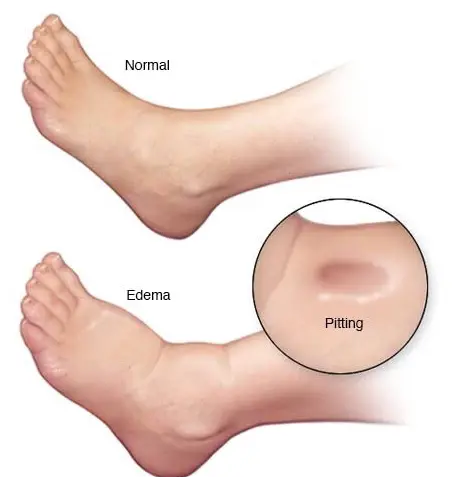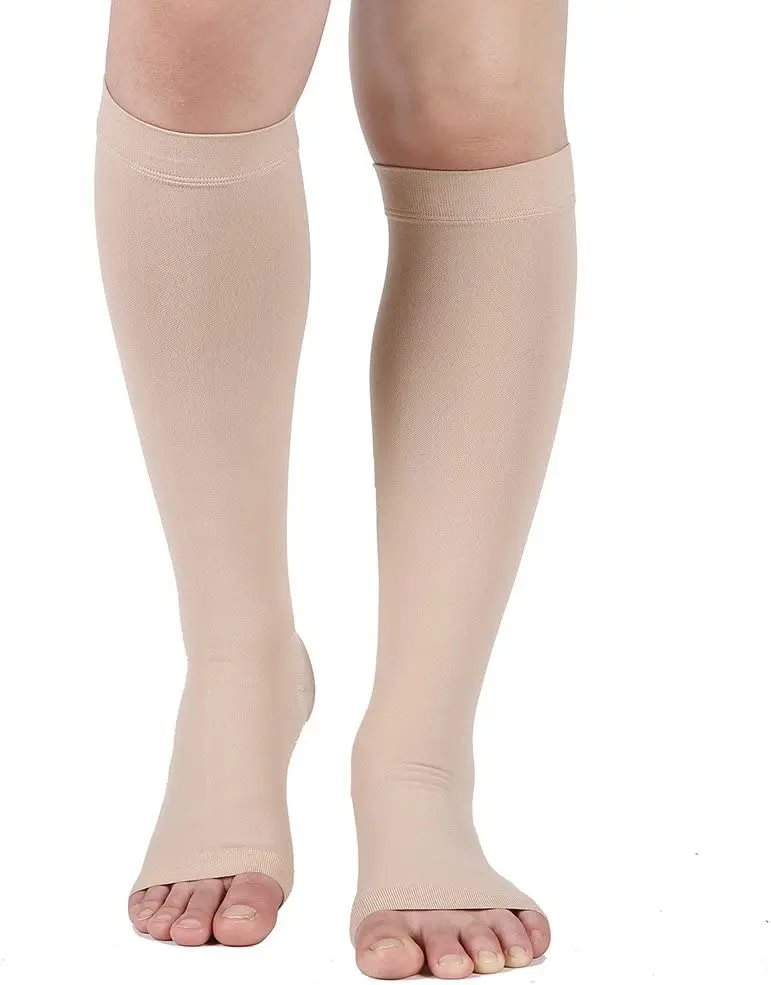Compression socks are a wonderful invention for people who need help with circulation, especially those who suffer from edema. However, you can’t just wear them all day – there’s a limit to how long you should wear your compression socks in order to get the best results.
So how long is that? And how much compression is too much compression? Let’s find out!
What is Edema?
Edema is a condition in which fluid collects in your tissues. It’s caused by a problem with the lymphatic system, which is responsible for removing excess fluid from the tissues.
In some cases, like after an injury or surgery, swelling can be temporary. But in others—like heart failure or chronic kidney disease—it may be permanent and lead to other health problems if left untreated.
The good news: You can take steps to prevent edema and/or manage it when you have it. One of those is wearing compression socks!

Causes Of Edema
Edema is caused by the body retaining too much fluid. Many factors can contribute to this, including:
There are also other medical causes such as inflammatory conditions, side effects from certain medications, and surgery.
Do compression socks help with edema?

Compression socks are effective treatments for edema. They are available in many different styles, colors, and materials such as nylon, cotton, and Lycra. They can reduce swelling of the feet and ankles by increasing the blood flow through these areas.
Compression socks can be worn during all kinds of physical activities including hiking or running but it is not recommended to wear them when you’re sleeping.
They might affect your circulation if you’re wearing them for too long at once time span i.e., more than 12 hours per day which could result in skin damage or even worse health problems like diabetes mellitus type II (DMII) which may lead to amputation because the foot swells up due to poor circulation.
Read: Benefits of Compression Socks
How Long To Wear Compression Socks For Edema
Compression socks are a good treatment option for edema. They can help reduce the symptoms of edema, including swelling and discomfort in your legs. Compression socks can also be worn regularly to prevent edema from coming back or getting worse.
If you’re suffering from leg edema, wearing compression stockings can help reduce swelling and improve blood circulation.
The compression stockings should be worn during the day and removed at night. They should be reapplied in the morning. If you’re wearing them on both legs, you should receive at least two pairs of stockings.
Feet sizes in Edema for compression socks
The first thing is that everyone’s feet are different – so each person needs their own personalized regimen. This can include the amount of time they need to wear their stockings, as well as what type of material they should be made from (for example cotton or nylon).
It may also depend on whether or not you have diabetes or another condition that affects circulation as well as any other medications which might affect circulation too much if taken regularly such as statins etcetera.
A doctor will usually prescribe some sort of treatment plan but if none exists yet then ask them how often I need to replace my stockings after washing them once a week should suffice in most cases where no other factors come into play like those just mentioned above!
health risks with wearing compression socks for the long term in edema
Compression Socks are not for everyone
If you have a medical condition that makes you prone to blood clots, such as deep vein thrombosis or pulmonary embolism, you should not wear compression socks. The risk of developing blood clots may be increased by wearing compression socks and thus could lead to life-threatening complications if left untreated.
Do not wear compression socks if you have diabetes
This is because the risk of developing skin ulcers and infections is higher when wearing compression garments like these ones compared with regular stockings and tights (study).
What Type of Sock is Suitable for Edema?
The answer is all of the above. Compression hose, ted, and stockings are all suitable for edema. However, compression hoses are more comfortable than ted and stockings.
Ted is more durable than compression hoses and stockings which makes it a great option if you need to wear them every day or every other day.
Compression hoses are a bit more expensive than ted and stockings as well but they can also be worn underneath your clothes which makes them much more convenient to wear during the day or when going out in public without looking like you’re wearing medical equipment!
Best Compression Socks For Edema
We have chosen a few socks for you that are appropriate for edema needs if you’re looking to buy compression socks for swelling.

Key Specifications:
Read: How To Choose The Right Compression Socks [Ultimate Guide]
Wearing Compression Stockings for Edema Can Reduce the Symptoms of this Condition
The pressure provided by the socks increases blood flow to the legs, which reduces swelling and improves circulation.
This is particularly beneficial in people who have poor blood circulation or who are experiencing problems with lymphatic drainage, as it will help keep fluid from collecting in their feet and ankles.
Compression stockings should be worn daily when you’re not exercising or performing any other activities that may cause you to sweat a lot.
It’s recommended that you wear them for at least 12 hours per day, but if necessary you can wear them longer than that (up to 18 hours).
However, if you start feeling pain due to constriction around your ankles or calves, it means that it’s time for another pair of stockings because those ones have become too small!
Also Read Our Compression Socks Reviews:
FAQs
Compression socks should fit comfortably. If they are pulling on your skin or causing pain, it may be an indication that they are too tight.
If you’re experiencing any discomfort while wearing your compression socks, try loosening them up some to see if this helps. You can also try wearing them for shorter periods of time at first to see how your body reacts.
The main cause of rashes and irritation is a poor fit. If your compression socks are too tight, they may cause itching, redness, and irritation. If the socks are too loose or do not fit well at all, you may notice temporary dents in your skin at the edge of the fabric.
A great way to treat edema is by wearing compression socks. Using them involves gently squeezing the legs, which causes the tissues beneath the skin to be compressed. By reducing excessive fluid leakage from capillaries, as well as increasing its absorption by capillaries and lymphatic vessels, excess tissue fluid can be reduced to a minimum.
Conclusion
In summary, wearing compression stockings for edema can significantly improve your quality of life. And while they won’t cure the condition, they will help reduce the symptoms and often eliminate them altogether. This allows you to get back to living your normal life without pain or swelling in your feet and legs all day long!
In some cases, this may even prevent complications such as blood clots forming on these surfaces that could lead to more complications.



